26 Templates: The Power of Follow-up – Enhancing Your Application with Strategic Letters
Welcome to our Application Follow-up Letters page! We understand the importance of staying engaged and making a lasting impression during the job application process. Here, we provide valuable insights and guidance on how to effectively use follow-up letters to enhance your candidacy and stand out as a top candidate. Whether you’re seeking to express gratitude, inquire about the status of your application, or provide additional information, our resources will help you navigate the art of follow-up letters with professionalism and finesse. Discover the power of follow-up letters in leaving a positive impression, maintaining a strong connection with employers, and increasing your chances of securing your dream job.
Introduction:
Follow-up letters play a crucial role in the job application process and can greatly impact your chances of standing out as a candidate. While submitting your application is the first step, following up demonstrates your proactive nature, professionalism, and genuine interest in the position. In a competitive job market, where employers receive numerous applications, a well-crafted follow-up letter can set you apart from other candidates and leave a lasting impression. It provides an opportunity to reinforce your qualifications, express gratitude, seek updates, address any concerns, and maintain a positive relationship with the employer. By leveraging the power of follow-up letters, you can showcase your dedication, attention to detail, and enthusiasm, ultimately increasing your chances of securing the job you desire.
Purpose and Benefits of Sending Follow-up Letters:
Follow-up letters serve multiple purposes and offer several benefits to job seekers. Here are some key purposes and benefits to highlight:
- Demonstrating professionalism: Sending a follow-up letter demonstrates your professionalism and commitment to the application process. It shows that you are proactive, organized, and genuinely interested in the position.
- Expressing gratitude: Follow-up letters provide an opportunity to express gratitude to the employer for considering your application. Showing appreciation for the opportunity to apply and be considered for the position leaves a positive impression.
- Seeking updates: Follow-up letters allow you to inquire about the status of your application. It shows your eagerness and proactive approach to staying informed about the progress of the hiring process.
- Reinforcing qualifications and interest: Follow-up letters provide a platform to reinforce your qualifications, skills, and experience that make you a strong fit for the position. You can reiterate your interest in the role and emphasize how your background aligns with the company’s needs.
- Addressing concerns or offering additional information: If there were any concerns or gaps in your application, a follow-up letter can be used to address them or provide additional information that supports your candidacy. It gives you an opportunity to clarify any misunderstandings and present yourself in the best light.
- Building a positive relationship: Sending a follow-up letter helps you build and maintain a positive relationship with the employer, even if you are not ultimately offered the position. It demonstrates your professionalism, respect, and gratitude, which can leave a lasting impression and potentially lead to future opportunities.
- Differentiating yourself from other candidates: Many applicants neglect to send follow-up letters, so by taking the initiative to send one, you differentiate yourself from the competition. It shows your commitment, attention to detail, and genuine interest in the position, which can make a favorable impression on the employer.
#1: Standard Follow-up Letter:
The general letter to follow up on your application. The purpose of a standard follow-up letter is to check on the status of your application after submitting it to an employer. It serves as a polite and professional way to express continued interest in the position and to inquire about the progress of the hiring process. This letter is typically sent a few weeks after applying and can help you stay on the employer’s radar, demonstrate your enthusiasm for the opportunity, and potentially prompt further communication or an interview invitation.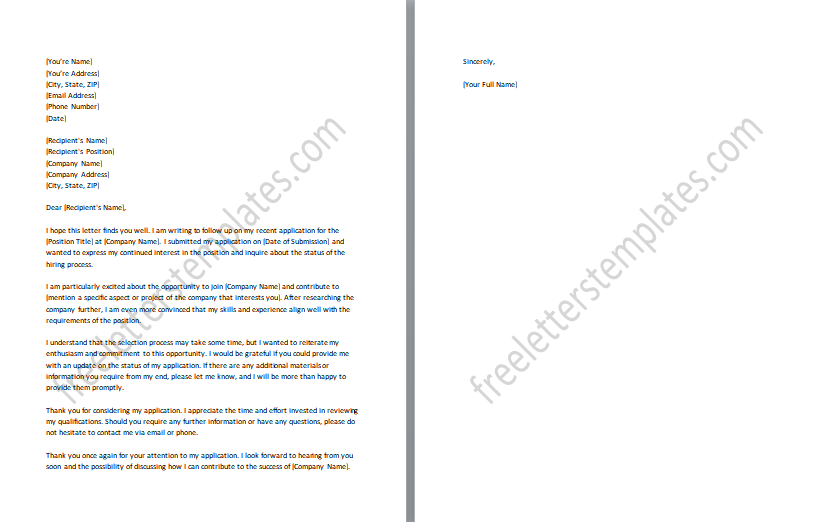
#2: Thank You Follow-up Letter:
Expressing gratitude for the opportunity to apply and reiterating your interest in the position. The purpose of a Thank You Follow-up Letter is to express gratitude to the employer for considering your application and allowing you to apply for the position. This letter allows you to convey your appreciation for their time and consideration. It also provides an opportunity to reiterate your interest in the position and highlight any key points from your application or interview that you would like to emphasize. Sending a Thank You Follow-up Letter shows professionalism, courtesy, and genuine interest in the opportunity, which can leave a positive impression on the employer and potentially enhance your chances of being considered for the position.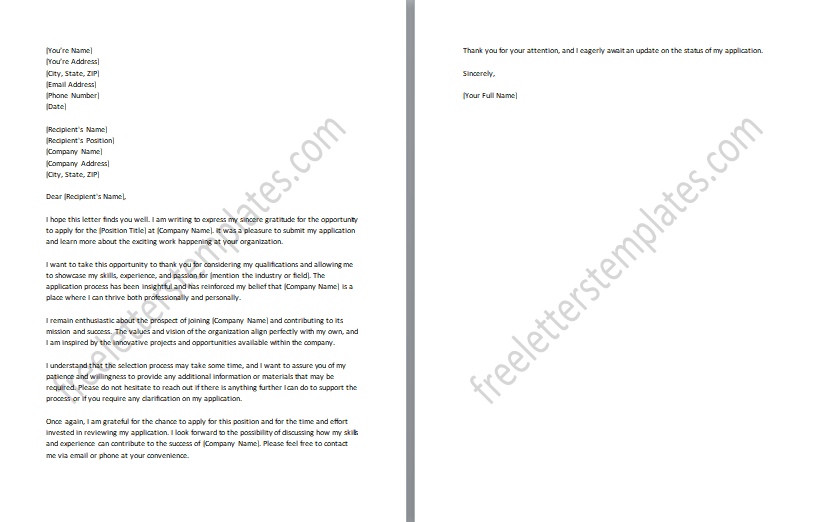
#3: Status Inquiry Follow-up Letter:
Requesting an update on the status of your application. A Status Inquiry Follow-up Letter is used to request an update on the status of your application from the employer. This letter serves as a professional and proactive way to seek clarification on where you stand in the hiring process. This letter helps you stay informed about the progress, allows you to manage your expectations, and shows the employer that you are actively engaged and committed to the opportunity.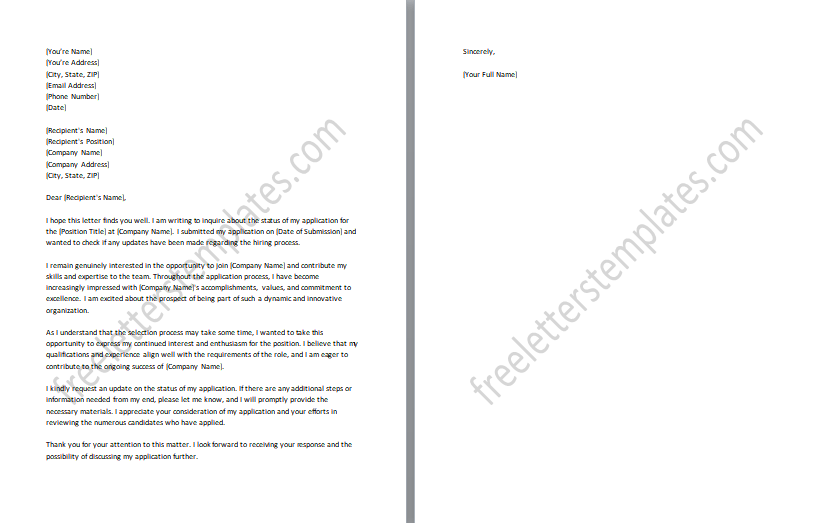
#4: Additional Information Follow-up Letter:
Providing additional relevant information to support your application. An Additional Information Follow-up Letter is used to provide supplementary and relevant information that can support your application. This letter allows you to share any new achievements, certifications, or experiences that have occurred since you initially submitted your application. It provides an opportunity to showcase your continued growth and qualifications, emphasizing why you are an ideal candidate for the position. By proactively sharing additional information, you demonstrate your dedication and enthusiasm for the opportunity, potentially strengthening your candidacy and leaving a positive impression on the employer.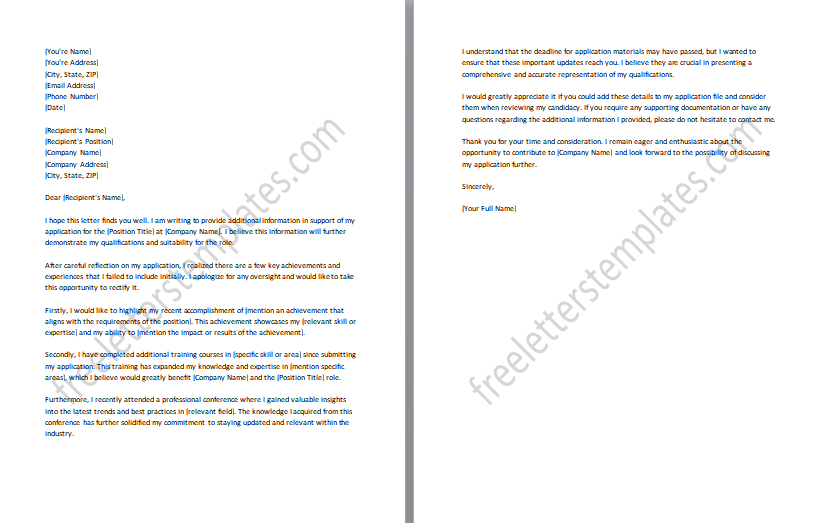
#5: Reference Follow-up Letter:
Asking if the employer has contacted your references and if they require any further information. The purpose of a Reference Follow-up Letter is to inquire whether the employer has contacted your references and to offer any further information that may be required. This letter allows you to confirm whether your references have been contacted and to provide any additional references or information that may strengthen your application. By following up on the reference check process, you demonstrate your proactive approach and a keen interest in the position.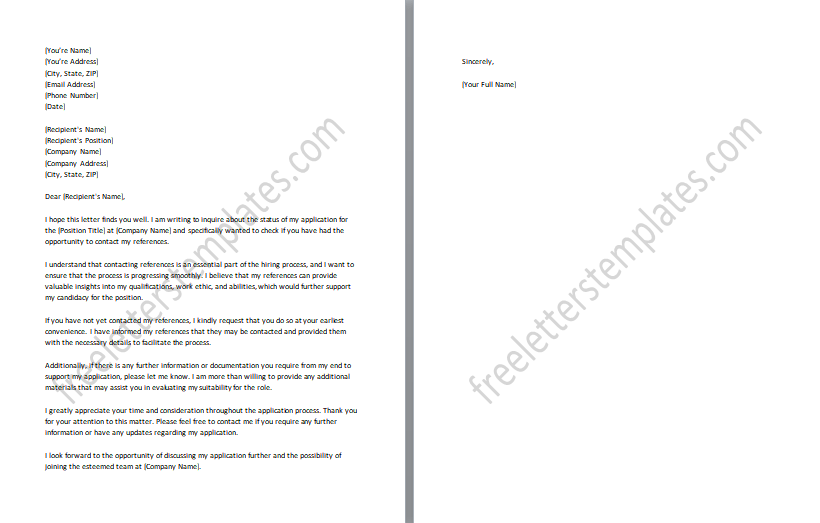
#6: Interview Request Follow-up Letter:
Requesting an interview after submitting your application. An Interview Request Follow-up Letter is used to formally request an interview with the employer after submitting your application. This letter demonstrates your enthusiasm and interest in the position, while also expressing your desire to further discuss your qualifications and suitability for the role. By requesting an interview, you are taking an active step in moving the application process forward and showcasing your eagerness to progress to the next stage. It is an opportunity to highlight your relevant skills and experiences once again and to reiterate your commitment to the opportunity.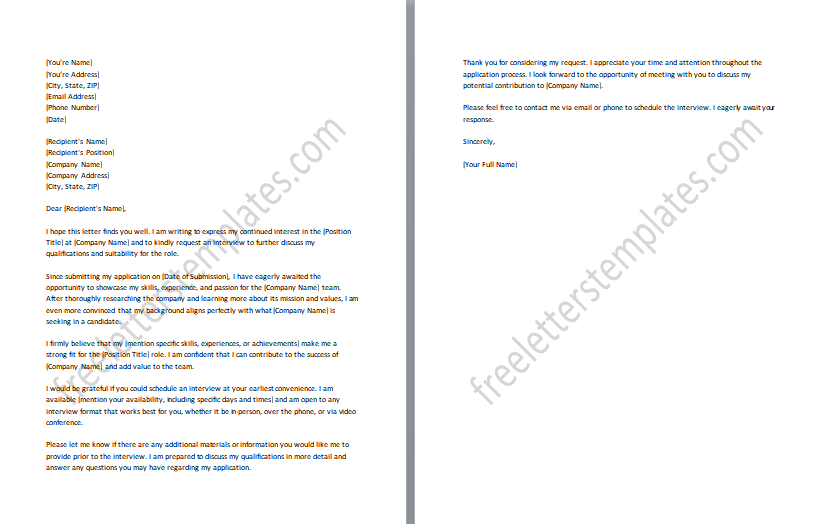
#7: Interview Confirmation Follow-up Letter:
Confirm the details of an upcoming interview. An Interview Confirmation Follow-up Letter is used to confirm the details of an upcoming interview with the employer. This letter serves as a professional and courteous way to acknowledge the scheduled interview and ensure that both parties are on the same page regarding the date, time, and location of the interview. It also allows you to express your gratitude for the opportunity and reiterate your interest in the position. Confirming the interview details through this letter shows your punctuality and professionalism, and helps to establish clear communication between you and the employer.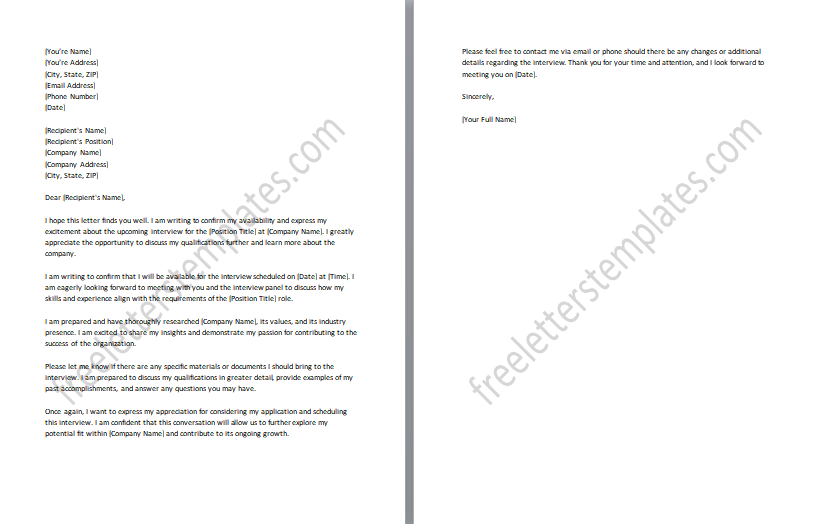
#8: Interview Thank You Follow-up Letter:
Sending a thank-you note after the interview and reiterating your interest. An Interview Thank You Follow-up Letter is used to express gratitude and appreciation to the employer after the interview. This letter allows you to thank the interviewer for their time, consideration, and the opportunity to discuss your qualifications and interest in the position. It is an opportunity to highlight specific aspects of the interview that resonated with you or further emphasize your qualifications. By sending a thank-you note, you demonstrate professionalism, courtesy, and a genuine interest in the position. It also provides an opportunity to reiterate your enthusiasm for the role and leaves a positive impression on the interviewer, potentially enhancing your chances of being considered for the position.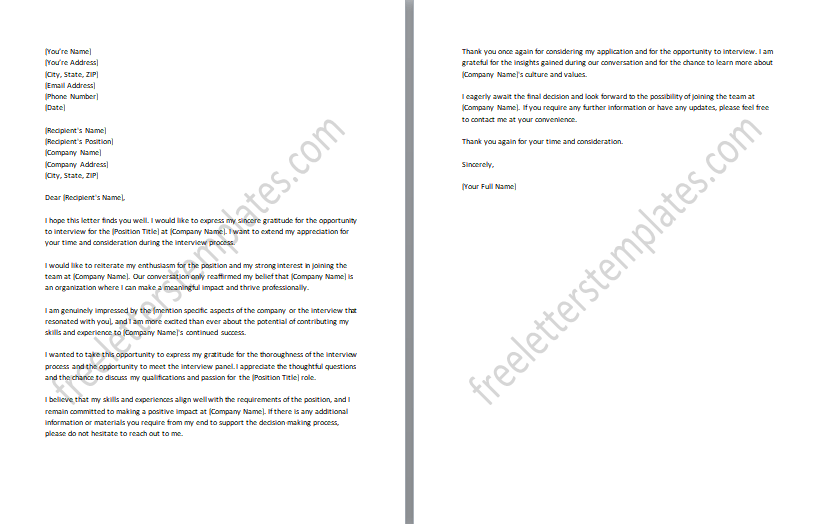
#9: Interview Follow-up Letter with Updated Information:
Providing additional information or documents discussed during the interview. An Interview Follow-up Letter with Updated Information is used to provide any additional information or documents that were discussed during the interview. This letter allows you to share any relevant materials or details that can further support your candidacy or address any questions or concerns that arose during the interview. By proactively providing this updated information, you demonstrate your attentiveness and commitment to the position. This letter helps to keep the lines of communication open and showcases your professionalism and dedication to the opportunity.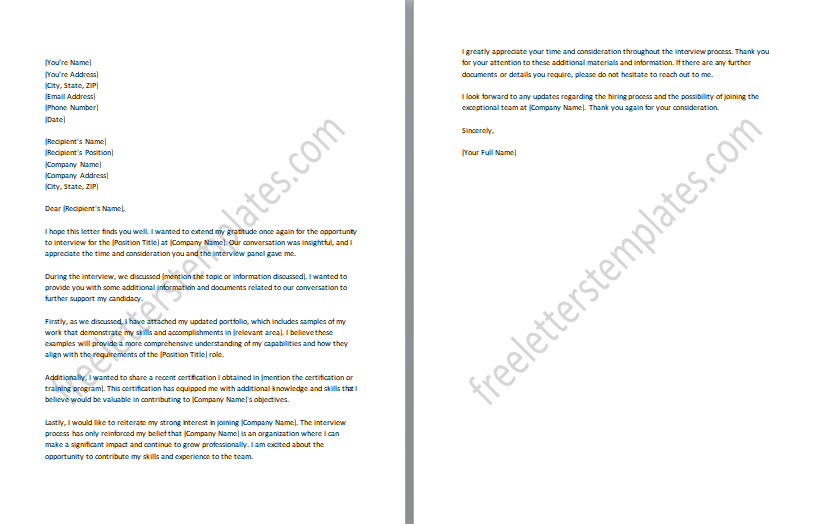
#10: Networking Follow-up Letter:
Follow up with someone you met through networking to inquire about job opportunities. A Networking Follow-up Letter is used to follow up with someone you met through networking to inquire about potential job opportunities. This letter allows you to maintain a connection and build upon the relationship you established during the networking event or meeting. It is an opportunity to express your gratitude for their time and insights and to express your continued interest in exploring potential job openings within their organization or industry. By reaching out and expressing your interest, you demonstrate your proactive approach to networking and your enthusiasm for connecting with professionals in your field.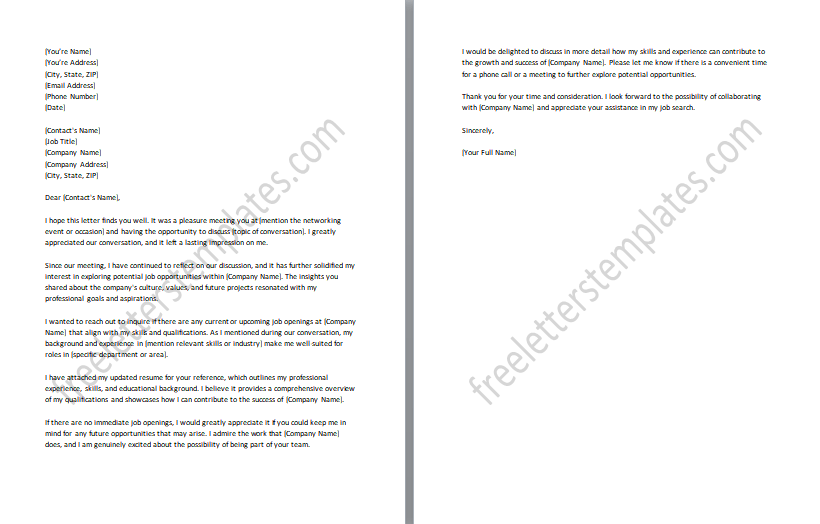
#11: Reapplication Follow-up Letter:
Following up on a previous application to express continued interest in the position. A Reapplication Follow-up Letter is used to follow up on a previous application to express your continued interest in the position. It allows you to update the employer on any relevant developments or achievements since your initial application and reaffirm your qualifications for the position. By reaching out again, you demonstrate your persistence and enthusiasm for the opportunity. This letter can potentially rekindle the employer’s interest in your application and prompt them to reconsider your candidacy. It is important to maintain a professional and positive tone in this letter, emphasizing your continued commitment and eagerness to contribute to the organization.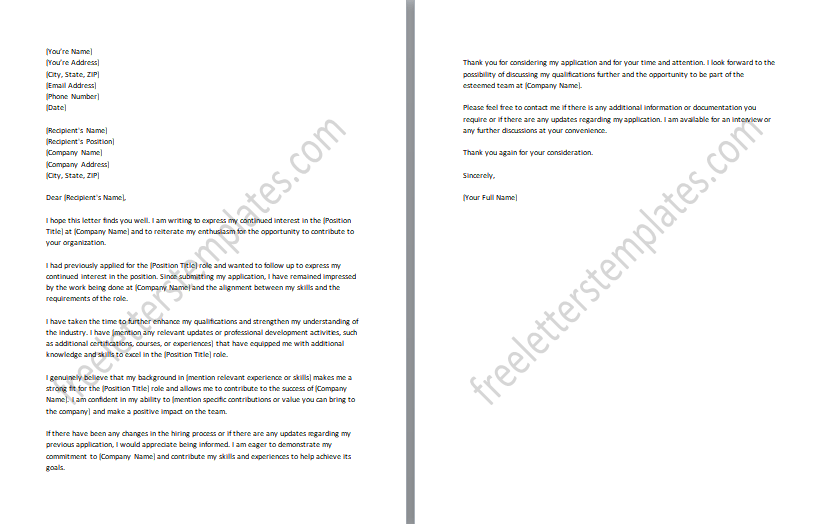
#12: Application Withdrawal Follow-up Letter:
Notifying the employer of your decision to withdraw your application. An Application Withdrawal Follow-up Letter is used to formally notify the employer of your decision to withdraw your application for a position. This letter serves as a professional and courteous way to communicate your decision and express your gratitude for the opportunity to be considered. By sending this letter, you demonstrate your professionalism and respect for the employer’s time and resources. It also helps maintain a positive relationship with the organization, should you consider applying for future opportunities.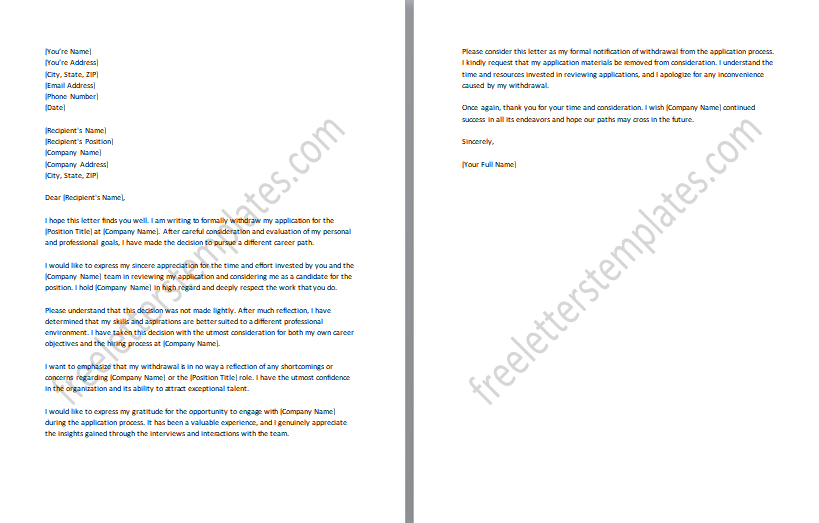
#13: Availability Follow-up Letter:
Provide your availability for an interview or any additional steps in the hiring process. An Availability Follow-up Letter is used to provide your availability for an interview or any additional steps in the hiring process. This letter allows you to communicate your schedule and availability to the employer, ensuring that they can plan and schedule accordingly. By proactively sharing your availability, you demonstrate your commitment and willingness to move forward in the hiring process. This letter helps facilitate efficient scheduling and communication between you and the employer, ultimately enhancing your chances of progressing to the next stage.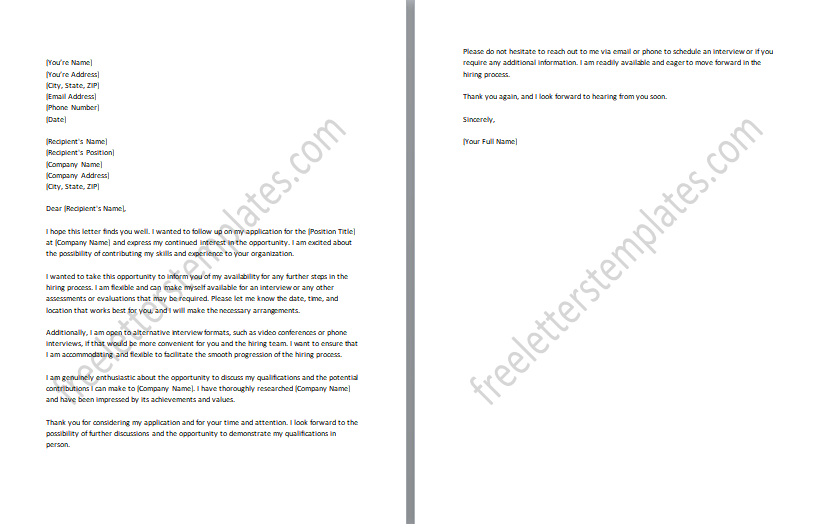
#14: Salary Negotiation Follow-up Letter:
Follow up on salary discussions and negotiations after an offer has been made. A Salary Negotiation Follow-up Letter is used to follow up on salary discussions and negotiations after receiving a job offer. This letter allows you to express your continued interest in the position while addressing the salary terms that were previously discussed. It provides an opportunity to clarify any points, present additional supporting information, or make a counteroffer based on your qualifications and market research. This letter can potentially lead to a mutually beneficial resolution regarding salary and help ensure that both parties are satisfied with the final offer. It is important to maintain a respectful and collaborative tone throughout the negotiation process.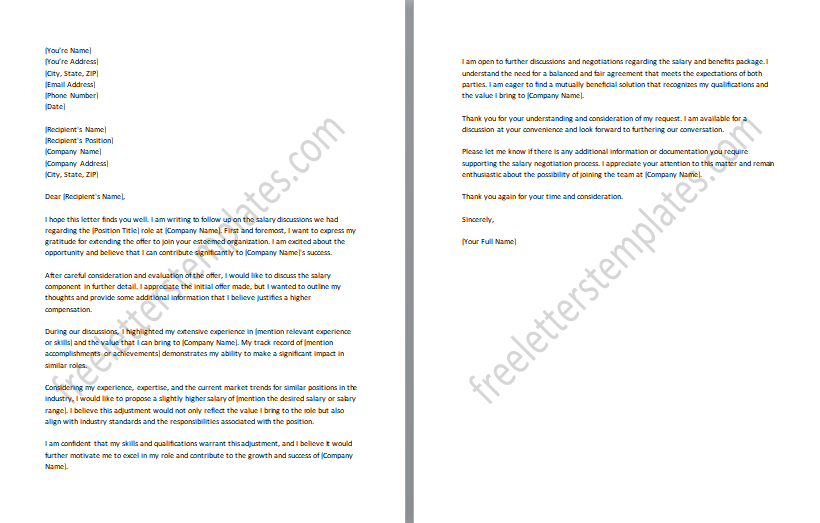
#15: Benefits Inquiry Follow-up Letter:
Inquiring about the benefits package associated with the position. A Benefits Inquiry Follow-up Letter is used to inquire about the benefits package associated with the position you have applied for. It provides an opportunity to assess the overall compensation package and understand the value that the organization places on employee benefits. By sending this letter, you demonstrate your interest in the position beyond just the salary and show that you are considering the long-term aspects of the employment opportunity. This letter can help you make an informed decision regarding the position and negotiate effectively during the hiring process.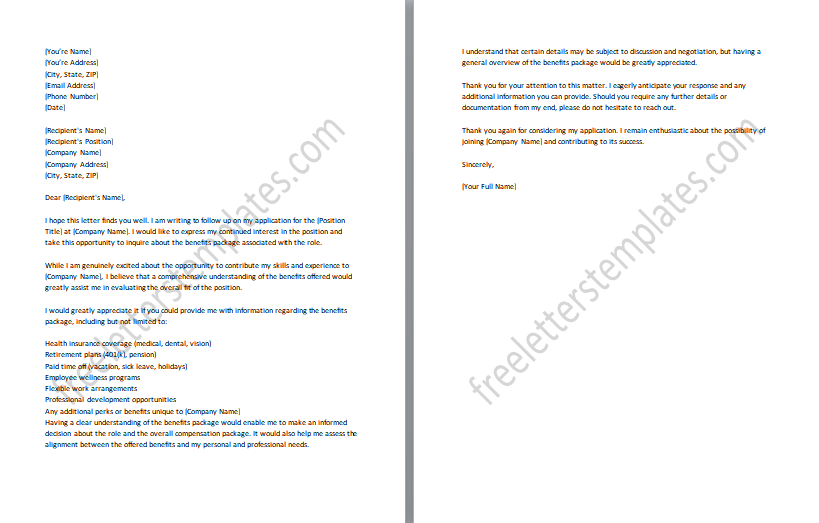
#16: Rejection Follow-up Letter:
Following up on a rejection to express gratitude and request feedback for future improvement. A Rejection Follow-up Letter is used to express gratitude to the employer for considering your application and to request feedback for future improvement, despite not being selected for the position. This letter allows you to maintain a positive and professional relationship with the employer and leaves a lasting impression. This can also leave a favorable impression on the employer, potentially increasing your chances of being considered for future roles within the organization or being recommended to other potential employers.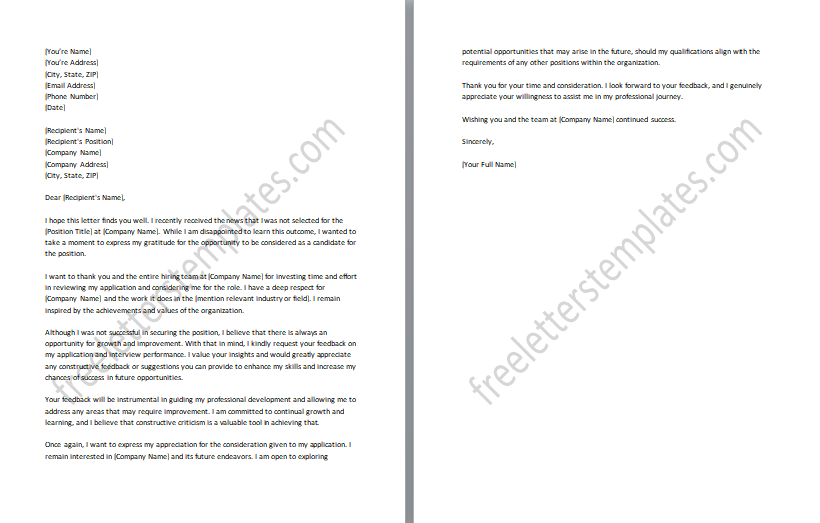
#17: Offer Acceptance Follow-up Letter:
Confirm your acceptance of a job offer and express appreciation. An Offer Acceptance Follow-up Letter is used to formally confirm your acceptance of a job offer and express appreciation to the employer. This letter serves as a written acknowledgment of your acceptance and ensures clear communication between you and the employer regarding your decision. It is an opportunity to express your gratitude for the opportunity, convey your excitement to join the organization, and reiterate your commitment to the role. This letter should include important details such as the position title, start date, and any other terms or conditions discussed during the offer process.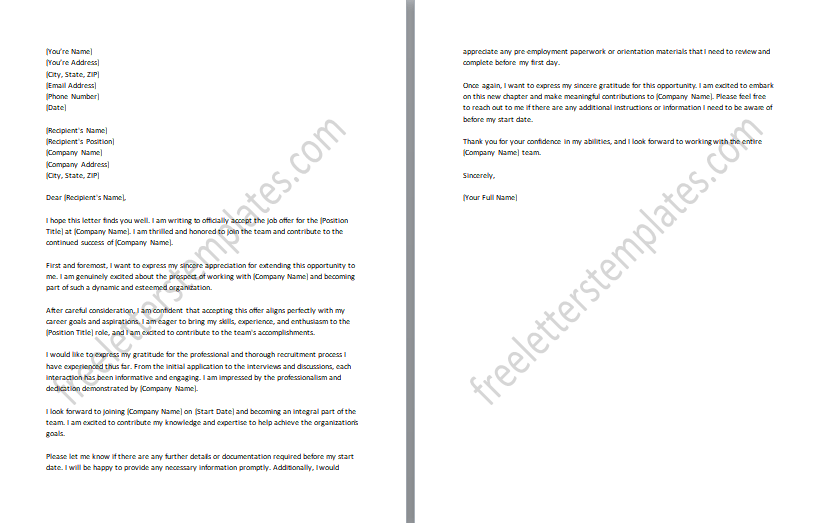
#18: Offer Decline Follow-up Letter:
Politely declining a job offer and expressing gratitude for the opportunity. An Offer Decline Follow-up Letter is used to formally decline a job offer and express gratitude to the employer for the opportunity. This letter allows you to communicate your decision respectfully and professionally, while also expressing appreciation for the time and consideration given to your application. It is important to convey your decision clearly and concisely, providing a brief explanation if necessary. Additionally, you can express your gratitude for the offer and acknowledge the positive aspects of the position or the organization.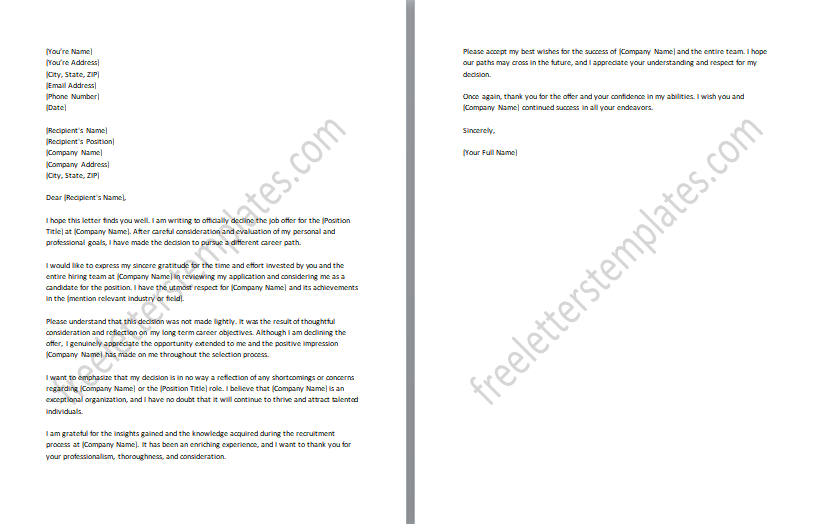
#19: Contract Follow-up Letter:
Following up on the status of the employment contract or agreement. A Contract Follow-up Letter is used to follow up on the status of the employment contract or agreement with the employer. This letter allows you to inquire about the progress of the contract preparation, review, or signing process. By sending this letter, you demonstrate your proactive approach and commitment to ensuring a smooth and timely transition into the role. This letter helps maintain open lines of communication and ensures that both parties are aligned on the contract details before finalizing the agreement.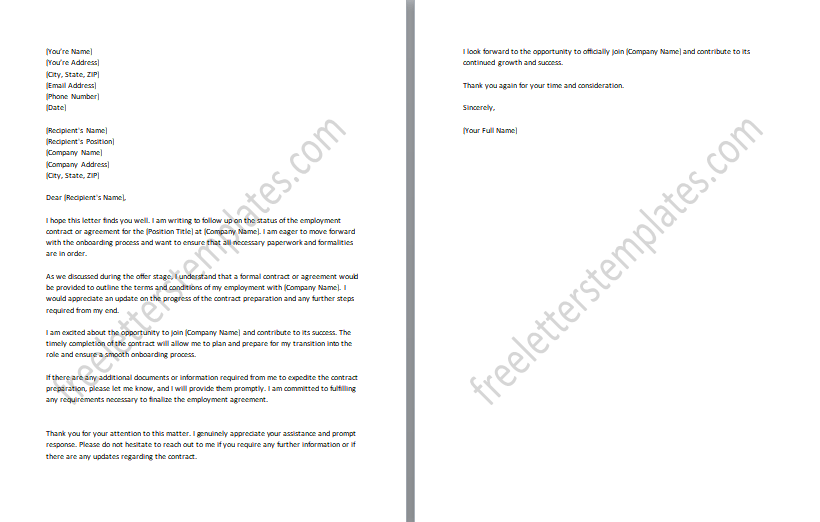
#20: Start Date Confirmation Follow-up Letter:
Confirm the agreed-upon start date for the position. A Start Date Confirmation Follow-up Letter is used to confirm the agreed-upon start date for the position with the employer. This letter serves as a written confirmation of the start date discussed during the hiring process. It is important to reiterate the exact date and any other relevant details such as the reporting time or location. This letter also helps to minimize any potential misunderstandings or scheduling conflicts and allows for proper planning and preparation for your arrival.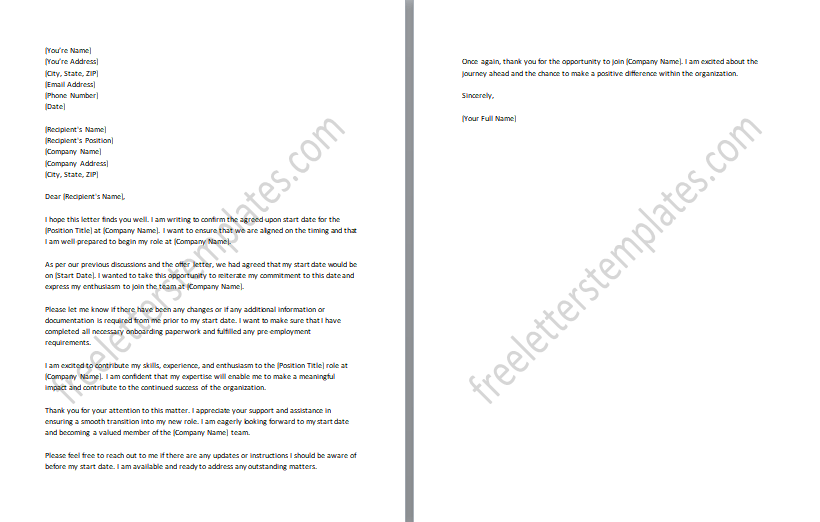
#21: Relocation Assistance Follow-up Letter:
Inquiring about any relocation assistance or benefits provided by the company. A Relocation Assistance Follow-up Letter is used to inquire about any relocation assistance or benefits provided by the company when considering a job offer in a different location. This letter allows you to seek clarification on the company’s relocation policy, reimbursement options, or any other support they may offer to facilitate your move. By sending this letter, you demonstrate your proactive approach to understanding the logistics and potential financial implications of relocating for the position. This letter can also serve as a basis for negotiating relocation benefits or allowances if they are not initially offered.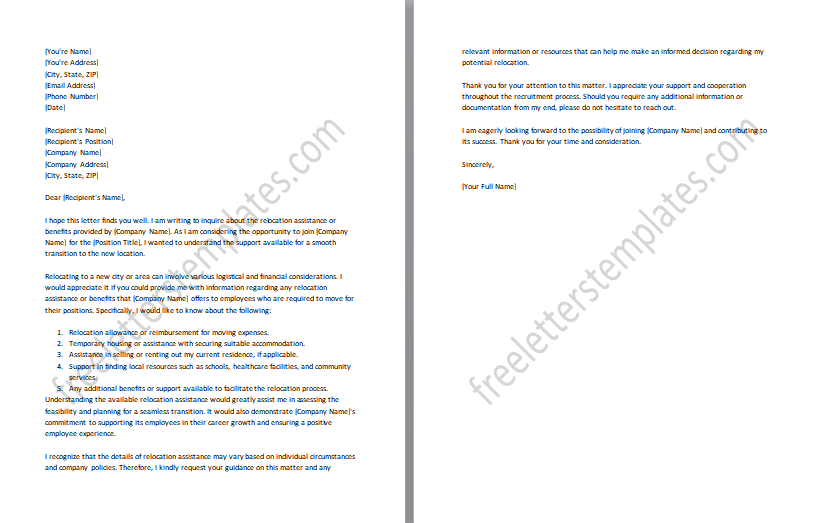
#22: Background Check Follow-up Letter:
Checking on the progress of the background check process. A Background Check Follow-up Letter is used to inquire about the progress of the background check process with the employer. This letter allows you to seek an update on the status of the background check and obtain any necessary information or documentation required to complete the process. By sending this letter, you demonstrate your proactive approach and commitment to ensuring a smooth hiring process. This letter helps maintain open lines of communication and ensures that both parties are informed and aligned regarding the background check requirements and timeline.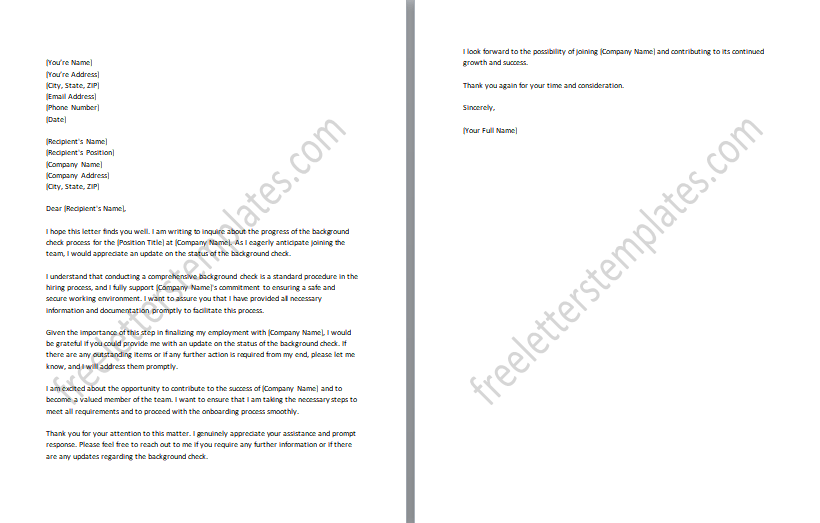
#23: Training and Orientation Follow-up Letter:
Inquiring about the details of the training and orientation process. A Training and Orientation Follow-up Letter is used to inquire about the details of the training and orientation process with the employer. This letter allows you to seek information about the training programs, schedules, or any other requirements related to your onboarding and integration into the organization. It is an opportunity to understand the expectations, resources, and support provided by the employer to ensure a smooth transition into your new role. By sending this letter, you demonstrate your enthusiasm and readiness to start your employment journey on the right foot.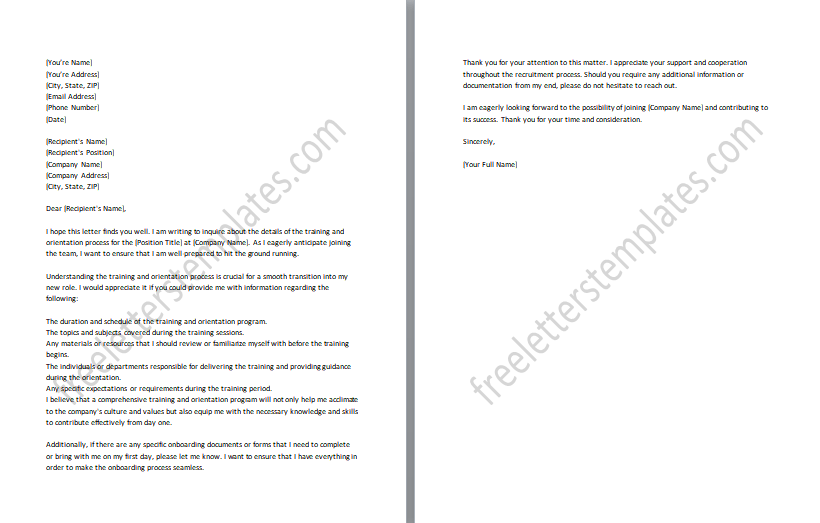
#24: Employment Agreement Follow-up Letter:
Following up on the signing and submission of the employment agreement. An Employment Agreement Follow-up Letter is used to follow up on the signing and submission of the employment agreement with the employer. This letter allows you to inquire about the progress of the agreement, confirm its receipt, or address any concerns or questions related to the terms and conditions outlined in the agreement. By sending this letter, you demonstrate your commitment to ensuring a smooth and timely completion of the required paperwork. This letter helps maintain open lines of communication and ensures that both parties are informed and aligned regarding the employment agreement process.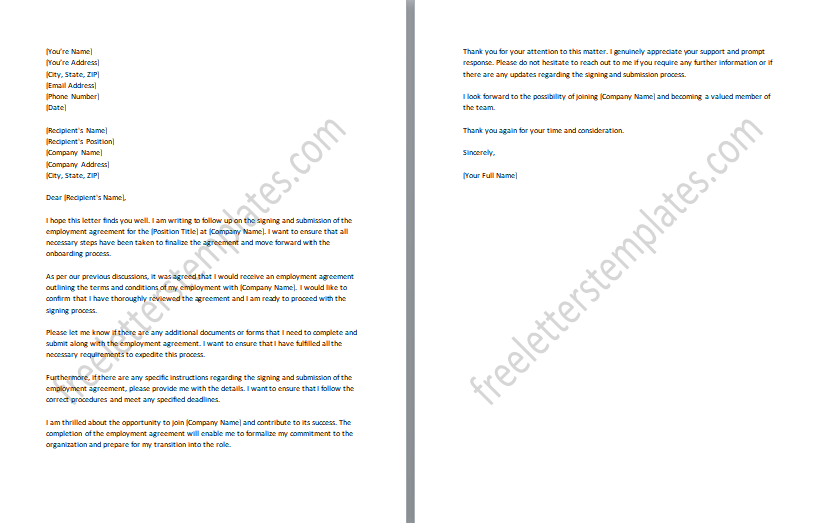
#25: Equipment or Technology Follow-up Letter:
Inquire about the equipment or technology you will be provided with for the job. An Equipment or Technology Follow-up Letter is used to inquire about the equipment or technology that will be provided to you for the job. This letter allows you to seek clarification on the tools, devices, or software that you will have access to to perform your duties effectively. By sending this letter, you demonstrate your proactive approach to understanding the technical aspects of the role and your commitment to being well-equipped for success. This letter helps to minimize any potential delays or difficulties in starting your job and allows you to adequately prepare for the use of specific equipment or technology.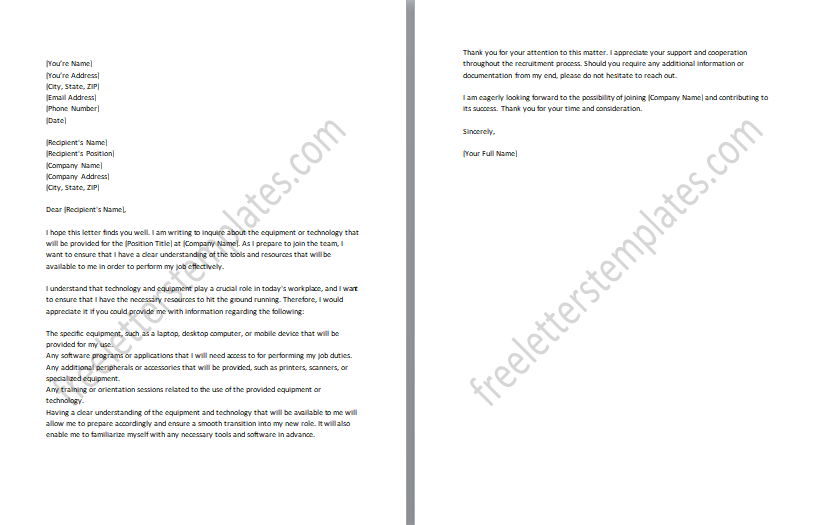
#26: Thank You and Goodbye Follow-up Letter:
Send a final thank-you note after the entire application process is complete, regardless of the outcome. A Thank You and Goodbye Follow-up Letter is used to send a final thank-you note after the entire application process is complete, regardless of the outcome. This letter allows you to express gratitude to the employer for the opportunity to participate in the application process, whether you were offered the position or not. This letter helps leave a positive impression and maintain a professional relationship, which may be beneficial for future opportunities or networking.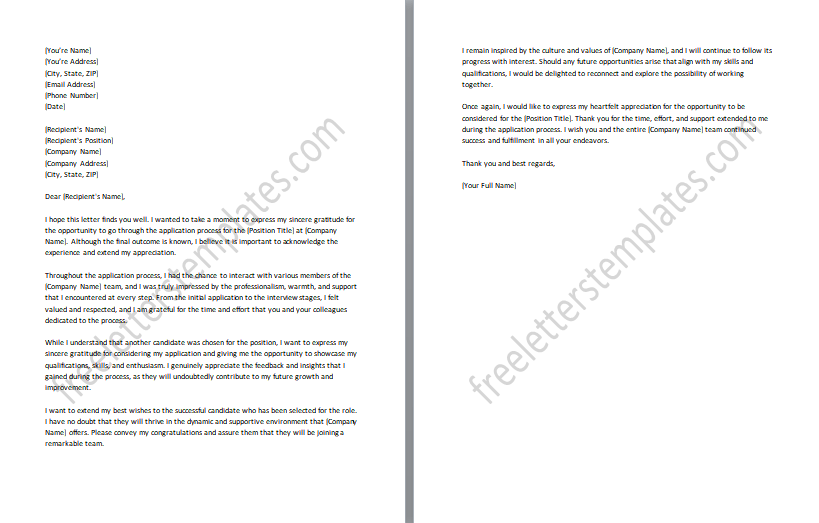
Tips for Writing Follow-up Letters:
When writing follow-up letters, consider the following tips to ensure their effectiveness:
- Properly address the recipient: Use the appropriate salutation and ensure the correct spelling of the recipient’s name to convey professionalism and attention to detail.
- Highlight key qualifications: Recap relevant qualifications and experiences that align with the position, emphasizing how they make you a strong candidate.
- Express enthusiasm and continued interest: Convey genuine enthusiasm for the opportunity and reiterate your interest in the role, showing that you remain invested in the position.
- Close on a positive note: End the letter with a positive tone, expressing gratitude for their time and consideration, and leave a lasting impression by reiterating your desire to contribute to the organization’s success.
Follow-up Letter Etiquette:
Follow these guidelines for proper etiquette when sending follow-up letters:
- Timing: Send your follow-up letter within a reasonable timeframe after submitting your application or after any relevant interview or interaction. Typically, within one to two weeks is appropriate, but adjust based on the company’s hiring timeline.
- Method of communication: Email is generally the preferred method for sending follow-up letters due to its speed and convenience. It allows for easy tracking and ensures your message reaches the recipient promptly. However, in some cases, such as for a more formal or traditional organization, sending a follow-up letter via postal mail may be more appropriate.
- Professional tone and formatting: Maintain a professional tone in your follow-up letter, using formal and courteous language. Use proper grammar, spelling, and formatting. Keep the letter concise, focusing on key points and keeping it to a single page if possible.
- Handling follow-up calls or inquiries: If you have not received a response to your follow-up letter within a reasonable timeframe, it is acceptable to make a polite follow-up call or send a brief email inquiring about the status of your application. Be patient and respectful when making such inquiries, recognizing that the hiring process may take time.
Professional Language and Tone
Maintaining a professional and respectful tone in follow-up letters is of utmost importance. It showcases your professionalism, maturity, and genuine interest in the position. When composing your letter, ensure that the language used is formal, courteous, and devoid of any negativity or desperation. Avoid sounding pushy or demanding, as it may create a negative impression. Instead, focus on expressing gratitude, highlighting your qualifications, and reiterating your enthusiasm for the opportunity. A professional tone demonstrates your ability to communicate effectively and handle situations with tact and grace. It helps build a positive image of you as a candidate and increases the likelihood of leaving a lasting impression on the employer. Remember, maintaining professionalism throughout the entire application process is crucial, including in follow-up letters, as it reflects your character and potential as an employee.
Final Thoughts:
In conclusion, when it comes to follow-up letters, it’s essential to tailor each letter to the specific situation. Recognize that every interaction is unique, and taking the time to personalize your follow-up letter demonstrates your attention to detail and genuine interest in the position. Express appreciation for the employer’s time and consideration throughout the hiring process. Remember, following up is not only a way to seek updates or express gratitude, but also an opportunity to showcase your dedication and interest in the position. By maintaining a professional tone, highlighting your qualifications, and reiterating your enthusiasm, you can leave a positive and lasting impression on the employer. So, don’t hesitate to send follow-up letters as part of your application strategy, as they can make a significant difference in the overall impression you make as a candidate.